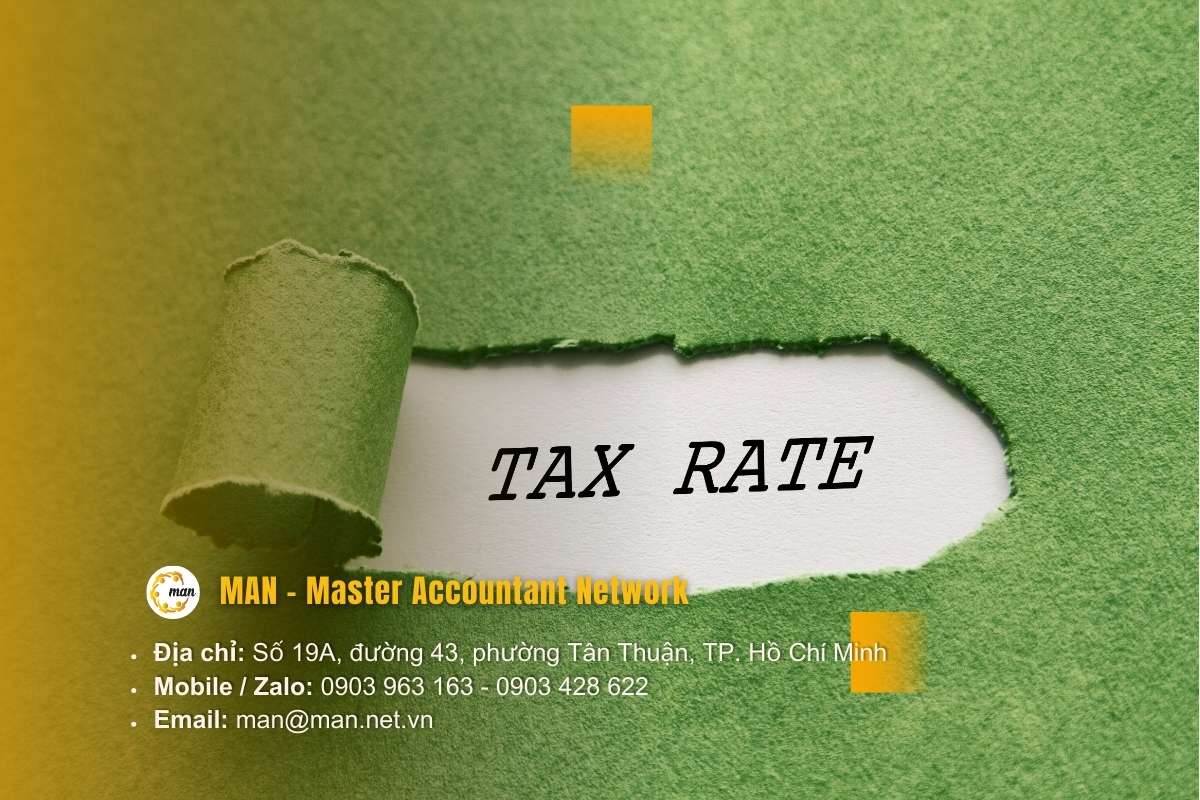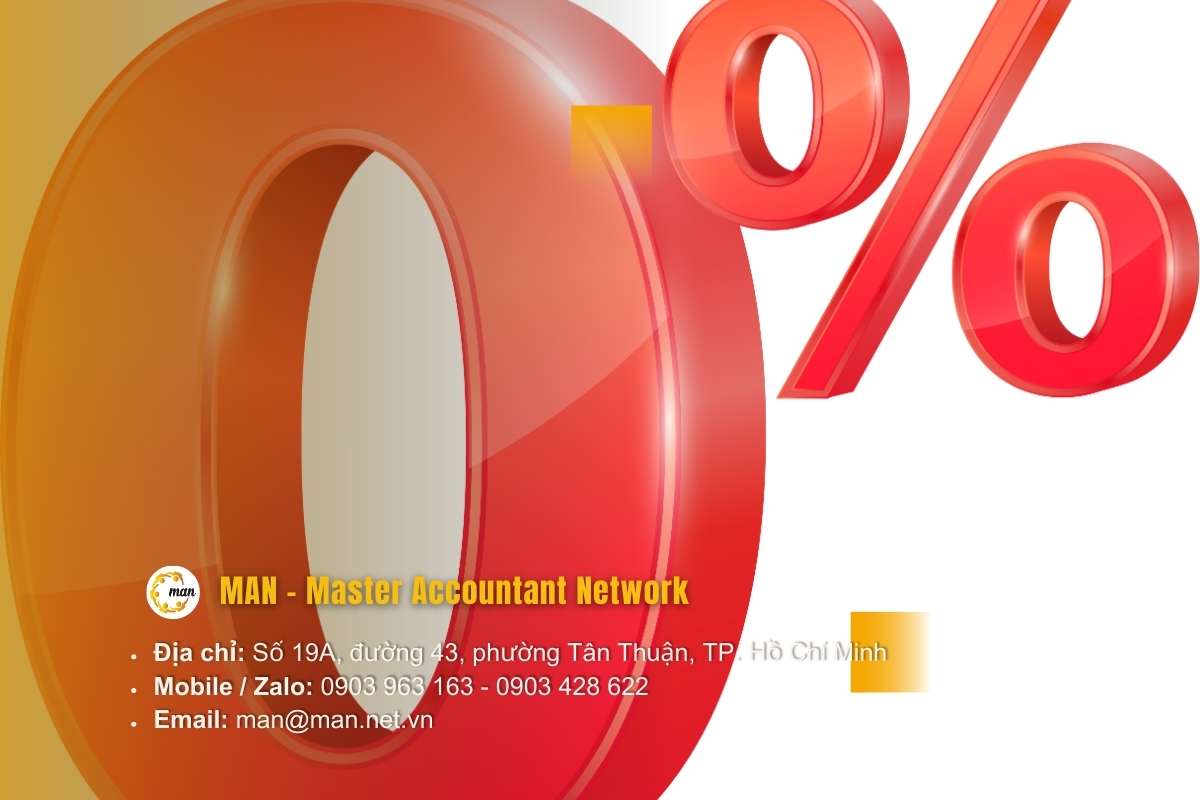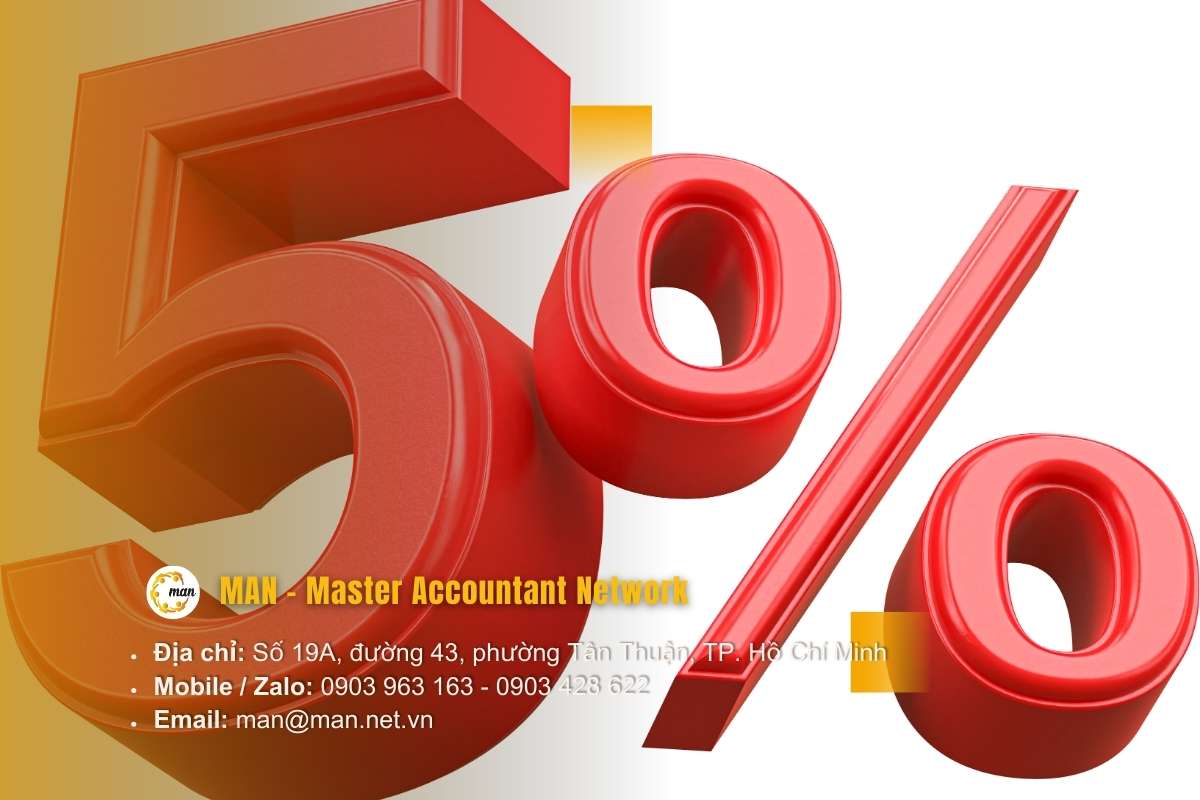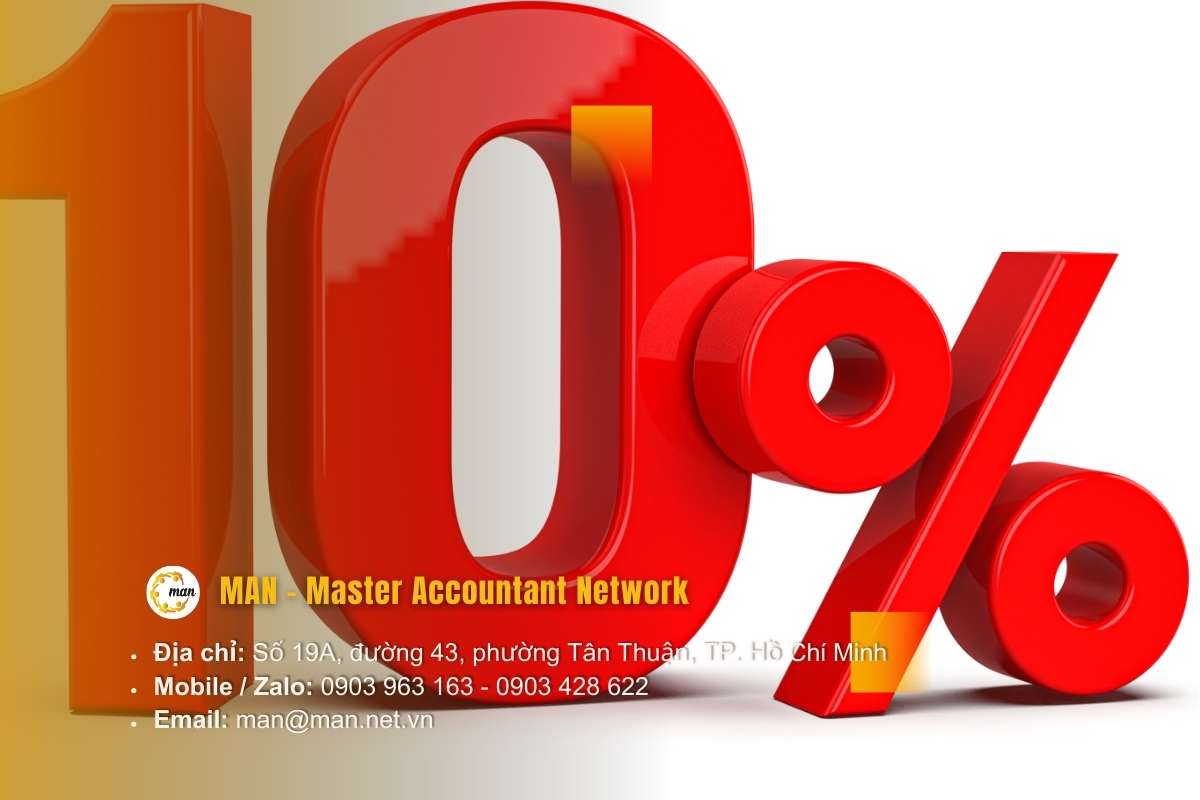What is the difference between the tax rates 0%, 5%, 8% and 10%? This is a question that many businesses and individuals are interested in when planning their finances and declaring VAT. According to the 2024 State Budget Revenue Report, VAT accounts for nearly 32% of total domestic revenue, affirming the key role of this tax in the economy.
From July 1, 2025, the new policy applies 4 tax rates: 0% for exported goods and services; 5% for essential groups such as food and clean water; 8% for groups reduced from 10%; and 10% is common for consumer goods and services. This classification both stabilizes the budget, regulates consumption and supports production.
Overview of VAT in Vietnam
What is VAT?
Value Added Tax (VAT) is an indirect tax, levied directly on the added value of goods and services arising in the process of production, circulation and consumption. Consumers are the ultimate tax payers, while businesses only play the role of collecting and paying back to the State. VAT has been widely applied in Vietnam since 1999, replacing the previous turnover tax, with the goal of creating a transparent, fair and internationally consistent tax system.
See more articles at: What is VAT? Subjects subject to VAT in 2025
The role of VAT
VAT is not only an important source of revenue for the state budget but also an effective economic regulation tool. With the input-output tax deduction mechanism, VAT helps avoid double taxation, encourages transparency in business activities, and creates a legal basis for businesses to deduct or refund taxes. In particular, VAT contributes to promoting exports when exported goods and services are subject to the tax rate 0%. Thanks to that, this tax policy both supports business integration and ensures budget balance.
VAT tax rates
In the VAT system in Vietnam, there are currently 4 main tax rates being applied. Each tax rate is designed to balance the State budget revenue and support socio-economic development.
Specifically including: tax rate 0%, tax rate 5%, tax rate 8% and tax rate 10%.

Each of these tax rates has its own role, both ensuring fairness in tax obligations and helping businesses and people be proactive in their production, business and consumption plans.
See more articles at: VAT Overview
Tax rate 0%
What is the tax rate 0%?
Tax rate 0% in value added tax (VAT) is the tax rate applied to exported goods and services, international transportation, goods and services not subject to consumption tax in Vietnam but consumed outside the territory. When applying this tax rate, enterprises do not have to pay output VAT but are still entitled to deduct and refund input VAT according to the law. This is a policy to encourage exports and enhance international competitiveness.

Subjects applying tax rate 0%
To apply the 0% tax rate correctly, businesses need to clearly understand the groups of goods and services that enjoy incentives and the cases that are excluded. According to Article 9 VAT Law 2024 and Articles 17, 18 Decree 181/2025/ND-CP, the applicable subjects are divided into: exported goods, exported services, other exported goods and services, and there are also cases that are not entitled to tax rate 0%. The table below summarizes the details for businesses to easily refer to and comply with the law.
| GROUP OF GOODS AND SERVICES | CONTENT OF APPLICATION OF TAX RATE 0% |
| Export goods |
|
| Export services |
|
| Other export goods and services |
|
| Cases where tax rate 0% is not applied |
|
Example of tax rate 0%
A textile and garment enterprise in Ho Chi Minh City signed a contract to export 5,000 shirts to the US market, with a total contract value of 2 billion VND. To apply the tax rate 0%, the enterprise prepared and submitted a complete dossier according to legal regulations, including:
- Export contracts signed with foreign partners.
- Customs declaration with confirmation of export.
- Commercial invoice records the value of the shipment.
- Bank payment documents in foreign currency.
In this case, the enterprise does not have to declare and pay output VAT for the export shipment. At the same time, all input VAT arising from raw materials, fabrics, accessories, and production costs for sewing shirts will be deducted or refunded according to regulations. This helps enterprises save costs and increase competitiveness when participating in the international market.
See more articles at: Major changes in on-the-spot import and export: Comparison before and after 1/7/2025 – MAN
Tax rate 5%
What is the 5% tax rate?
The 5% tax rate is a preferential value-added tax (VAT) rate applied to a number of essential goods and services to reduce the cost burden on people and support socio-economic development. According to Article 9 of the 2024 VAT Law and guidance in Decree 181/2025/ND-CP, these items include clean water, fertilizers, medical equipment, textbooks, children's toys, science and technology services, and a number of goods and services serving agricultural production and social housing.

The 5% tax rate helps balance between encouraging consumption of essential goods, ensuring social security, and still generating revenue for the State budget.
Subjects applying tax rate 5%
| GROUP OF GOODS AND SERVICES | APPLICATION DETAILS |
| Clean water | Serving production and daily life; not including bottled water, jarred water and other soft drinks |
| Fertilizer, ore | Production of fertilizers, pesticides, and animal growth stimulants in accordance with the law |
| Agricultural services | Digging, dredging canals, ditches, ponds and lakes; cultivating, caring for, preventing and controlling pests; processing and preserving agricultural products |
| Agricultural, forestry and fishery products | Planted trees, forests (except wood, bamboo shoots), livestock, unprocessed or only pre-processed aquatic products; except for products specified in Clause 1, Article 5 of the Law on Value Added Tax |
| Latex & Materials | Crepe rubber, sheet rubber, vermicelli rubber, rice husk rubber; nets, twine, fishing net yarn |
| Handicraft & Agricultural Products | Jute, sedge, bamboo, leaves, straw, coconut husks, coconut shells, water hyacinth; carded/carded cotton; newsprint |
| Agricultural Equipment & Vehicles | Fishing vessels; machinery and equipment specialized for agricultural production |
| Medical Equipment & Pharmaceuticals | Medical equipment according to law; disease prevention and treatment drugs; pharmaceutical substances and medicinal materials used as raw materials for drug production |
| Teaching and learning equipment | Model, drawing, board, chalk, ruler, compass |
| Art | Traditional and folk performing arts activities |
| Toys & Books | Children's toys; books of all kinds (except books specified in Clause 15, Article 5 of the Law on VAT) |
| Science and technology services | According to the Law on Science and Technology |
| Social housing | Sale, lease, lease-purchase under Housing Law |
Example of tax rate 5%
A practical example of the 5% tax rate can be illustrated by the case of a publisher in Hanoi. This publisher publishes 10,000 textbooks for domestic schools, with a total value of up to 1.5 billion VND. Thanks to the application of the 5% VAT rate, instead of having to declare output tax at the standard rate of 10% like normal goods, the publisher only has to pay VAT at the preferential rate of 5%.
The application of this tax rate not only helps reduce the direct costs for schools when purchasing books but also reduces the economic burden on students and parents. At the same time, this preferential tax policy encourages publishers to maintain reasonable book prices, promotes educational publishing activities and effectively supports financial resources circulating in the education sector. As a result, schools and students benefit from access to knowledge at lower costs, while the state still ensures reasonable tax management.
See more articles at: VAT tax rates and corresponding taxable subjects in 2025 – VN Tax
Tax rate 10%
What is the tax rate 10%?
The 10% tax rate is the common VAT rate in Vietnam, applied to most non-preferential goods and services according to Article 9 of the 2024 VAT Law. This is the standard rate, ensuring budget revenue and financial balance. The tax applies to consumer products, commercial services, transportation, entertainment, and digital services, e-commerce from foreign suppliers, helping transactions to be transparent and fair.

Subjects applying tax rate 10%
The tax rate of 10% is applied to all goods and services that are not subject to tax incentives (ie not included in the list of goods and services subject to tax rates 0% or 5%). This means that most common consumer products and services, commercial services, domestic transportation or entertainment services are subject to this tax rate.
In addition, the 10% tax rate also applies to services provided by foreign suppliers without a permanent establishment in Vietnam to organizations or individuals in Vietnam. This includes digital services, e-commerce, online platforms such as software, applications, streaming services, or sales through international e-commerce platforms. This helps ensure tax fairness between domestic and foreign suppliers, while contributing to increasing budget revenue.
Example of tax rate 10%
An electronics store in Hanoi sells 500 televisions with a total invoice value of VND5 billion to domestic customers. Since this item is not eligible for preferential tax rates 0% or 5%, the store will declare and pay output VAT at the rate of 10% on the total invoice value, equivalent to VND500 million.
In the case of digital services, a Vietnamese company purchases graphic design software from a foreign supplier via an e-commerce platform. This service is also subject to VAT rate 10%, even though the supplier does not have a base in Vietnam. This tax declaration helps ensure fairness between domestic and international suppliers, while increasing transparency and revenue for the budget.
Tax rate 8%
What is the tax rate 8%?
Tax rate 8% is the value added tax (VAT) rate applied to some specific goods and services, lower than the standard tax rate 10%. On June 30, 2025, the Government issued Decree 174/2025/ND-CP according to Resolution 204/2025/QH15 of the National Assembly, stipulates that the VAT rate for groups of goods and services currently applying the rate of 10% will be reduced to 8% from July 1, 2025 to December 31, 2026. The purpose of this policy is to support encouraged sectors and industries to develop, while reducing the cost burden on consumers.
Subjects applying tax rate 8%
Goods and services not eligible for VAT reduction
According to Decree 174/2025/ND-CP, some groups of goods and services are not eligible for VAT reduction, including:
- Telecommunications, financial activities, banking, securities, insurance, real estate business, metal products, mining products (except coal).
- Goods and services subject to special consumption tax (except gasoline).
Goods and services with reduced VAT
The remaining groups of goods and services currently applying the tax rate of 10% will be reduced to 8%, except for the groups of goods and services not subject to VAT reduction mentioned above.
Example of tax rate 8%
A skills training center opens a course with a tuition fee of VND 2,000,000 per student. According to Decree 174/2025/ND-CP, educational services are subject to VAT rate 8%. The VAT payable is calculated by multiplying the service price by the tax rate, i.e. VND 2,000,000 × 8% = VND 160,000.
Thus, students will pay a total of VND 2,160,000, of which VND 2,000,000 is tuition fee and VND 160,000 is VAT. Applying the tax rate of 8% helps reduce costs compared to the tax rate of 10%, while encouraging the development of education and training services.
See more articles at: VAT reduction in 2025 based on Decree 174/2025/ND-CP – VN Tax
Compare tax rates 0%, 5%, 8% and 10%
VAT rates 0%, 5%, 8% and 10% are applied depending on the type of goods, services and policy objectives. The 2024 VAT Law and guiding decrees such as Decree 174/2025/ND-CP clearly stipulate the subjects, application period and corresponding incentives. The table below summarizes and compares these tax rates according to many criteria, helping businesses and people easily grasp and apply.
| CRITERIA | TAX RATE 0% | TAX RATE 5% | TAX RATE 8% | TAX RATE 10% |
| Applicable objects | – Export goods and services
– Goods sold to duty free shops – International transportation – Export processing services – Construction and installation works abroad or in non-tariff zones |
– Clean water for production and daily life
– Ore for production of fertilizers, pesticides, growth stimulants – Sale and rental of social housing |
Goods and services currently subject to tax rate 10% but reduced to 8% from July 1, 2025 to December 31, 2026, except for goods and services that are not subject to reduction according to Appendix I of Decree 174/2025/ND-CP | Goods and services not subject to 0%, 5% or 8% |
| Policy purpose | Encourage exports, reduce costs for export enterprises, support international competition | Support essential industries, protect people's lives, encourage the development of social housing | Support businesses and consumers in difficult economic context, reduce costs, promote consumption | Standard tax rate, ensuring budget revenue |
| Time of application | Applicable continuously, without any specific time limit except for other export or preferential regulations | Continuously applied to groups of goods and services listed by law | From 01/07/2025 to 31/12/2026 | Continuous for remaining items, not in the promotion group |
| Illustrative example | – Rice export 100 million VND → VAT 0 VND
– International transportation service 50 million VND → VAT 0 VND |
- Clean water for daily use sold for 1 million VND → VAT 50,000 VND - Social housing sold for 500 million VND → VAT 25 million VND | – Education services 2,000,000 VND → VAT 160,000 VND – Medical examination and treatment 500,000 VND → VAT 40,000 VND | – Normal commercial goods and services 1 million VND → VAT 100,000 VND |
| Legal Note | Law on VAT 2024 Article 9, Decree 181/2025/ND-CP Articles 17-18 | Law on VAT 2024 Article 10-11, Circular 219/2013/TT-BTC Article 10-11 | Decree 174/2025/ND-CP, Resolution 204/2025/QH15 | VAT Law 2024 Article 8-10, Circular 219/2013/TT-BTC |
See more articles at: VAT Rate – VN Tax
VAT policy trends in the coming time
In the coming period, VAT policy is oriented towards supporting businesses, stimulating consumption, and at the same time ensuring stable budget revenue. This is a necessary balance to both nurture revenue and promote production and business development.
One of the notable points is the continued application of temporary tax reduction measures for a number of groups of goods and services. The tax rate 8% applied from July 1, 2025 to December 31, 2026 is a specific example of this policy, aiming to reduce costs for businesses and consumers in the context of many economic fluctuations.
In addition, the scope of preferential tax rates is likely to be expanded to essential sectors such as education, healthcare, or environmentally friendly products. This not only encourages important sectors for social life but also contributes to sustainable consumption orientation.
In addition, VAT declaration and management procedures will be increasingly reformed towards simplification and digital technology application. This helps reduce administrative burdens for businesses, increase transparency and improve tax management efficiency.
Finally, VAT policy is also expected to be more flexible to adapt to macroeconomic fluctuations, control inflation and comply with international trade commitments.
Conclude
VAT with tax rates 0%, 5%, 8% and 10% is not only a tool for managing budget revenue, but also an important lever to promote production, consumption and support businesses in each stage of development. Understanding the differences between tax rates, as well as promptly grasping policy changes, will help businesses be more proactive in building financial plans, minimizing legal risks and making the most of legal incentives from the State.
In a context where tax policies are constantly adjusted to adapt to the economic situation, working with a reputable consulting firm is a key factor. MAN – Master Accountant Network not only provides businesses with professional accounting and tax solutions, but also serves as a knowledge bridge to help you quickly update new regulations, optimize costs and operate your business more effectively. Connect with MAN now for comprehensive support, timely tax policy updates and sustainable development orientation for your business.
Contact information:
MAN – Master Accountant Network
- Address: No. 19A, Street 43, Tan Thuan Ward, Ho Chi Minh City
- Hotline: 0903 963 163 – 0903 428 622
- E-mail: man@man.net.vn




